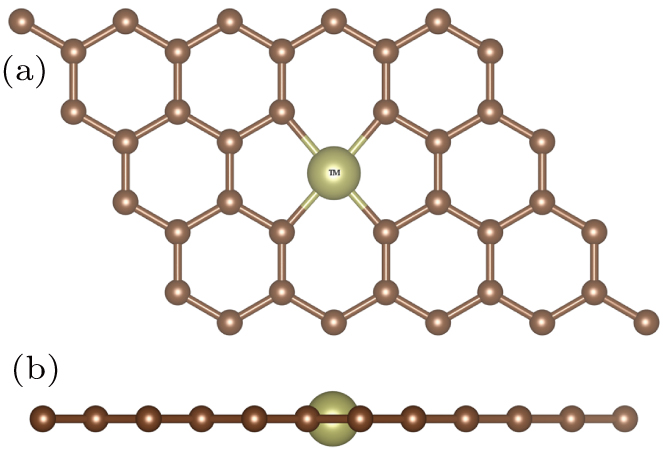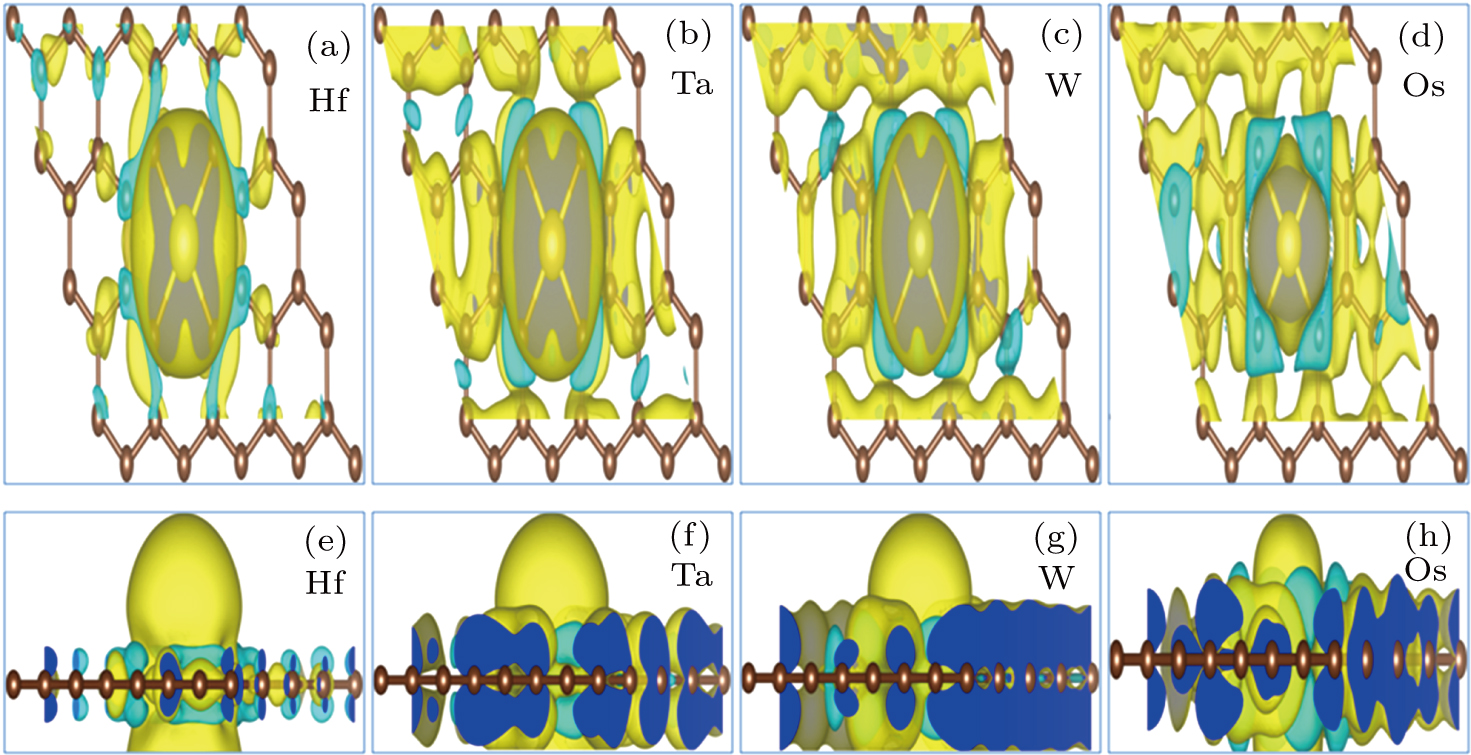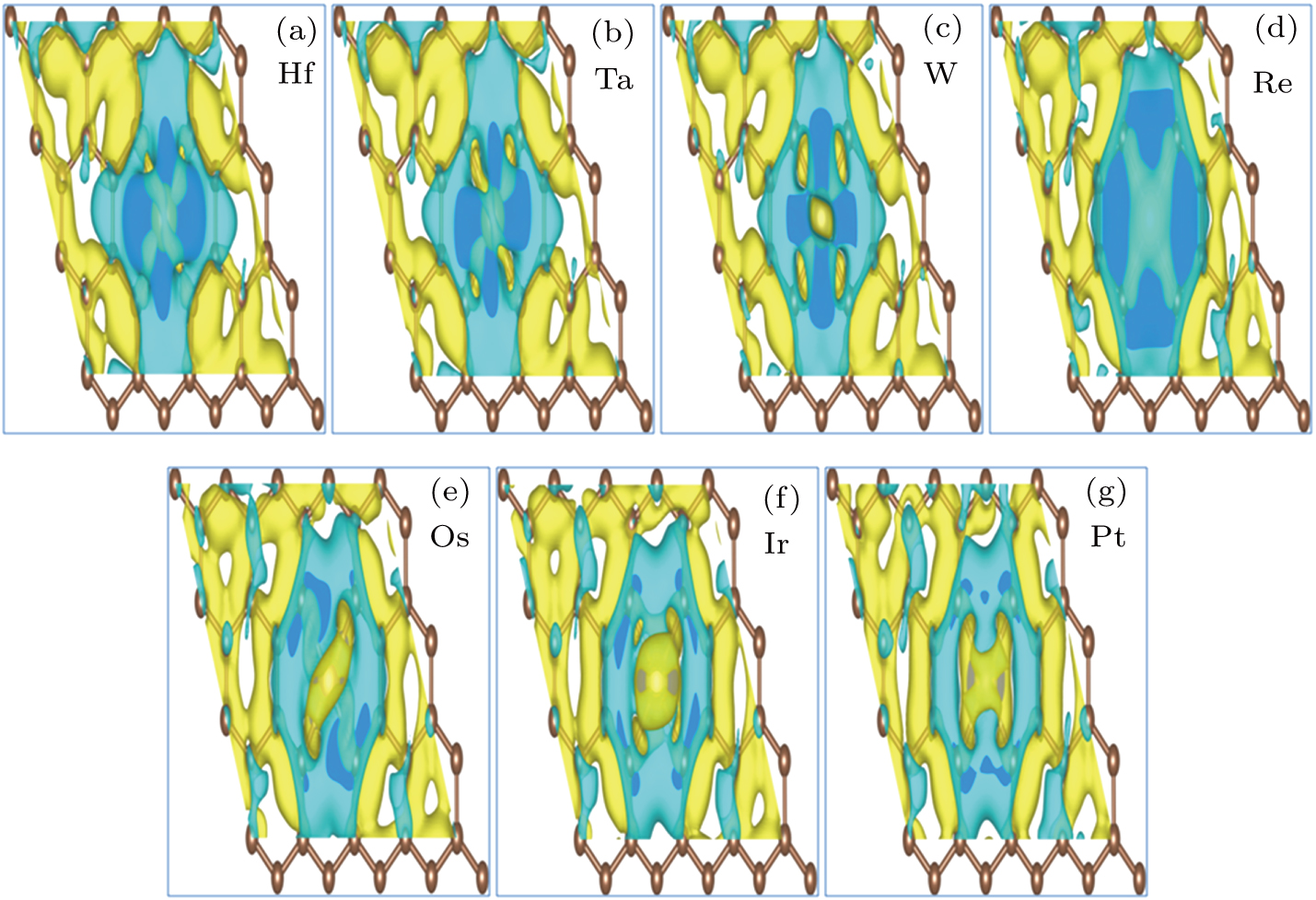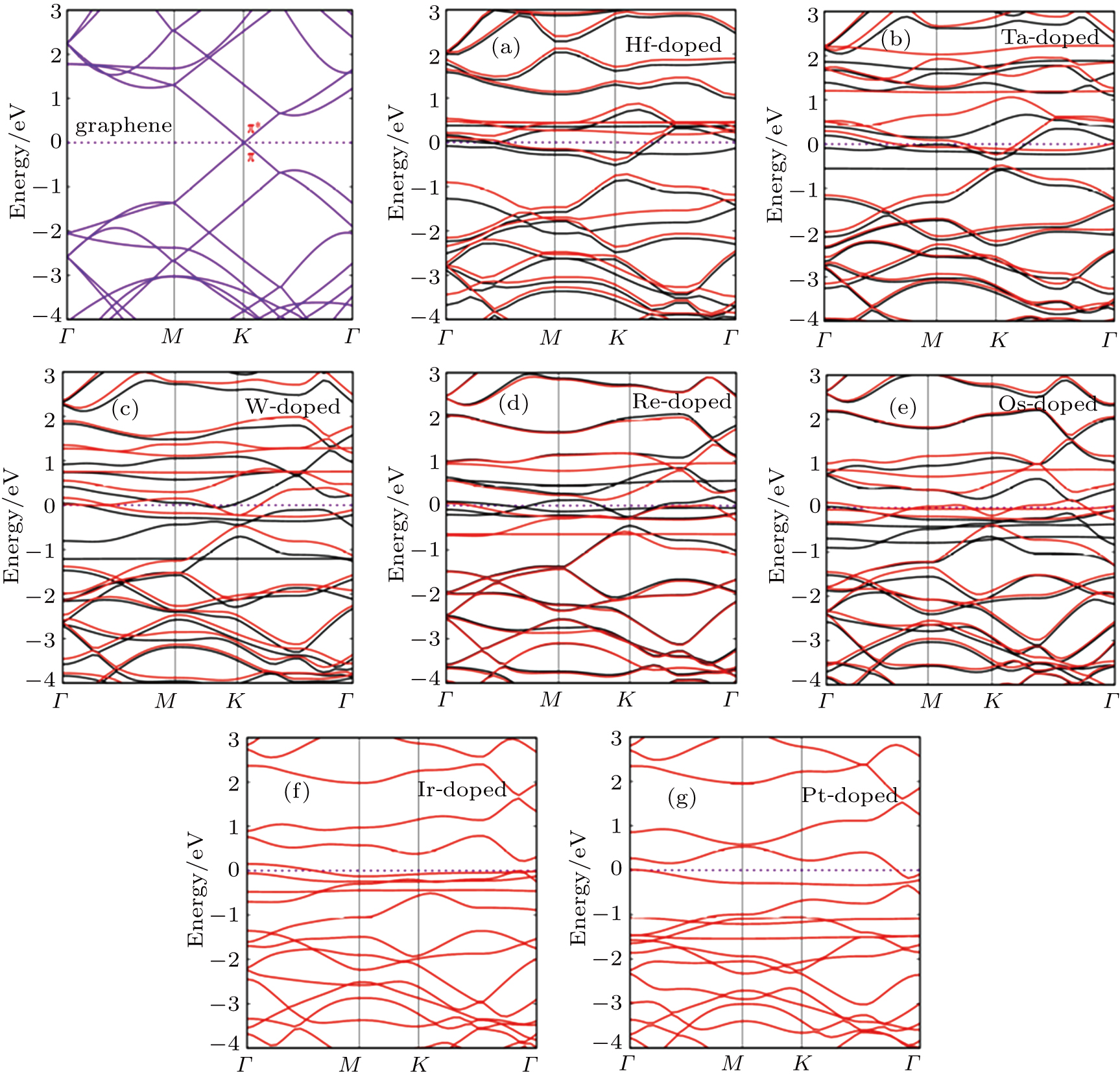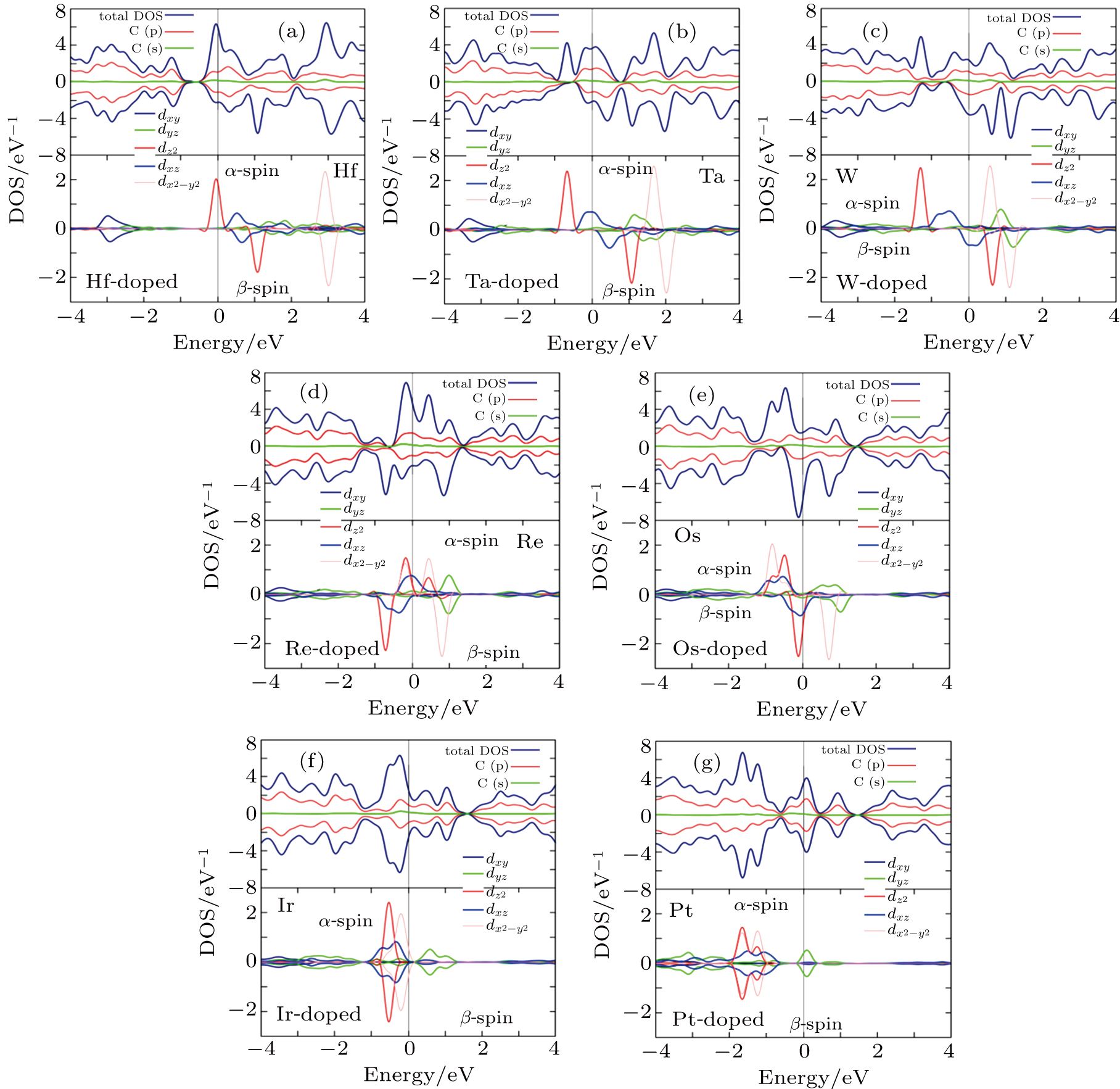† Corresponding author. E-mail:
Structural, electronic, and magnetic behaviors of 5d transition metal (TM) atom substituted divacancy (DV) graphene are investigated using first-principles calculations. Different 5d TM atoms (Hf, Ta, W, Re, Os, Ir, and Pt) are embedded in graphene, these impurity atoms replace 2 carbon atoms in the graphene sheet. It is revealed that the charge transfer occurs from 5d TM atoms to the graphene layer. Hf, Ta, and W substituted graphene structures exhibit a finite band gap at high symmetric K-point in their spin up and spin down channels with 0.783 



Graphene, a two-dimensional (2D) layered structure of carbon atoms,[1,2] due to its unique electronic, mechanical, thermal, and other outstanding properties[3–7] has attracted a surge of interest recently. The charge carriers in graphene behave like massless Dirac fermions due to the linear dispersion of energy near the Fermi energy level.[7] The charge mobility in excess of 200000 cm
In conjunction to that, dilute magnetic semiconductors (DMSs) and half metals have been under extensive experimental and theoretical research over the last decade.[9–17] 2D spintronic devices such as spin filters, spin diodes, and spin transistors can be achieved by introducing magnetism in 2D materials.[18–20] In addition, the long spin diffusion length and rather long spin lifetime make graphene an appropriate material for designing graphene based spintronic devices.[21] Given the unique structure of graphene, with planar sp2 bonding and 
In order to broaden the applications of graphene as a magnetic material in novel spintronic devices, various approaches have been utilized to introduce ferromagnetism behavior in monolayer graphene, nanotubes, and silicone.[21–26] Presently, there are two main approaches widely utilized for substituting transition metal (TM) atoms into graphene to induce magnetic moments in the graphene layer. The first approach is to adsorb TM atoms on graphene sheet. Studies indicate that adsorbed TM atoms bind strongly to graphene sheet[27] and their migration barrier is low enough to be mobile at room temperature.[28] Another feasible approach to control the electronic and magnetic properties of graphene is substitutional doping of foreign atoms into graphene containing single vacancy (SV) or divacancy (DV) of carbon atoms. Various studies have been performed to determine the structural, electronic, and magnetic properties of individual TM atoms embedded into SV and DV graphene sheets. These studies indicate that, the individual TM atoms are effective substitutional dopants in graphene and their binding with C atoms is covalent and rather strong.[28–32] Available methods for introducing impurities into graphene include the synthesis of hybridized grapheme,[33,34] intercalation,[35] chemical modification,[36] low energy ion implantation,[37] and defect assisted doping by electron beam irradiation.[38–40] By using first-principles calculations, the effects of 3d and 4d metal atom impurities on electronic and magnetic properties of graphene have also been addressed in the previous studies.[30,33,34,41–44] However, most of the previous work available on 5d TM atom-decorated graphene has been based on their adsorption effect, without considering the effect of substitutional doping of graphene with 5d TM atom impurities.[45–49] For example, using first-principles calculations, Sun et al.[50] proposed that magnetism in arsenene can be achieved by doping Ti, V, Cr, Mn, and Fe atoms. The authors also reported that, half metallic states can be achieved in arsenene by substituting Ti and Mn atoms, while spin-polarized semiconducting states can be achieved by V, Cr, and Fe atom doping. In addition, Sun et al.[51–56] have dedicated a sufficient amount of work to manipulating the electronic and magnetic properties of phosphorene, germanene, and silicene by substituting different impurity atoms. Very recently, Sun et al.[27] performed a first-principles study on electronic and magnetic behaviors of 5d TM atom substituted SV graphene. The authors reported that TM atom substitution into SV graphene is thermodynamically favorable and induces ferromagnetism behavior in complex structures. That study is focused on TM atom substitution into SV graphene. Thus, could the graphene layer also achieve larger ferromagnetism and display DMS behavior after substituting 5d TM atoms at the DV site?
In this study, we aim to explore the electronic and magnetic properties of 5d TM atom substituted DV graphene. All the 5d TM impurity atoms are tightly bonded with neighboring C atoms in graphene as indicated by robust hybridization. Given their lower binding energies and increased magnetic moments, 5d TM atom-doped DV graphene structures are suitable for utilization in magnetic substrates to induce magnetism in graphene. To the best of our knowledge, the structural, electronic, and magnetic properties of such a system have not been well understood and the study on this topic remains unfinished and scattered. Therefore, a comprehensive theoretical study is timely at present.
The structural, electronic, and magnetic properties of 5d TM atom-doped DV monolayer graphene were investigated using first-principles density functional theory (DFT) method. The DFT method has already proven to be one of the most accurate methods for the computation of the electronic structure of solids.[57–62] All the calculations were performed in spin-polarized mode. The projector augmented wave (PAW) potentials[63] with Perdew–Burke–Ernzerhof (PBE) functional[64] were utilized by Vienna ab-initio simulation package (VASP).[65] A kinetic energy cutoff of 500 eV was used for wave function expansion. Our structure model consists of a 5 × 4 monolayer graphene supercell with a vacuum layer of 15 Å in the Z-direction to eliminate the interaction between adjacent layers. The Brillouin zone (BZ) was sampled using a 7 × 7 × 1 Γ-centered k-point mesh. All the structures were fully optimized until the Hellmann–Feynman forces were less than 0.01 eV/Å and the total change in energy was less than 10−6 eV. A Gaussian smearing method was utilized to deal with the partial occupancies. All our calculations were performed at temperature T = 0 K. Bader analysis was used to calculate the charge transfer.[66,67] Due to a controversial difference between GGA PBE functional predictions and high level GW and BSE results for graphene, we tested both LDA and PBE functionals to determine the band gap sensitivity. We found that, the band gap is not very sensitive to the functional choice. Both functional parameters predicted similar band gap values with a minimal variation of approximately 0.02 eV in the band gap results.
Different 5d TM atoms, i.e., Hf, Ta, W, Re, Os, Ir, and Pt, were embedded into DV monolayer graphene, depicted by an “X” symbol in the structure as shown in Fig.
For all cases of 5d TM atom substitution into DV monolayer graphene, it is observed that the TM atom placed at the DV site maintains its position in the planar structure of 2D graphene without getting elevated above the plane. It is due to strong covalent bonding between four C atoms around the DV site. However a minute local deformation is observed and a small change in bond length between neighboring C–C atoms is obtained. Figure
 | Fig. 2. (color online) Top views of atomic structures of 5d TM atoms incorporated into DV monolayer graphene showing bond lengths of TM–C and C–C atoms. Bond length is in units of Å. |
Table 










| Table 1.
Total magnetization of the supercell ( |
Total magnetic moments 









After analyzing spin densities (
 | Fig. 4. (color online) Comparison of magnetic moments of 5d TM atoms doped 5 × 4 DV monolayer graphene (this study) to the magnetic moments of 5d TM atoms doped 4 × 4 SV monolayer graphene in Ref. [27]. |
In order to further understand the behaviors of 5d TM atoms embedded in DV monolayer graphene, we examine the charge transfer using Bader analysis[66,67] for TM atom-doped DV graphene structures. The charge density difference is defined as 



In this section, the band structure and density of states (DOS) plots are investigated for 5d TM atom-doped DV monolayer graphene structures. For band structure calculations, 20 points are collected along each high symmetry line using path Γ–M–K–Γ in the irreducible Brillouin zone to obtain the band structure with a very fine grid. Total and projected density of states (PDOS) are calculated for all 5d TM atom-doped structures using an 11 × 11 × 1 Γ centered Brillouin-zone sampling and the energy eigenvalues are smeared with Gaussians of width 0.02 eV. The band structure and DOS plots were calculated in spin-polarized mode.
Figures 

From the obtained results of band structure diagrams for 5d TM atom-doped DV graphene structures given in Figs. 



Spin polarized TDOS and PDOS for all the TM atom-doped DV graphene structures are analyzed to understand the different effects after TM atom substitution into DV graphene. TDOS and PDOS on the doped TM atoms, C atom p orbital, and C atom s orbitals for Hf, Ta, W, Re, Os, Ir, and Pt doped DV monolayer graphene are shown in Figs. 

















The structural, electronic, and magnetic behaviors of 5d TM atom-doped DV monolayer graphene structures were investigated by means of first-principles calculations based on density functional theory (DFT) method. It is observed that 5d TM atom substitution into DV monolayer graphene can produce ferromagnetism coupling in graphene. Spin densities 





| [1] | |
| [2] | |
| [3] | |
| [4] | |
| [5] | |
| [6] | |
| [7] | |
| [8] | |
| [9] | |
| [10] | |
| [11] | |
| [12] | |
| [13] | |
| [14] | |
| [15] | |
| [16] | |
| [17] | |
| [18] | |
| [19] | |
| [20] | |
| [21] | |
| [22] | |
| [23] | |
| [24] | |
| [25] | |
| [26] | |
| [27] | |
| [28] | |
| [29] | |
| [30] | |
| [31] | |
| [32] | |
| [33] | |
| [34] | |
| [35] | |
| [36] | |
| [37] | |
| [38] | |
| [39] | |
| [40] | |
| [41] | |
| [42] | |
| [43] | |
| [44] | |
| [45] | |
| [46] | |
| [47] | |
| [48] | |
| [49] | |
| [50] | |
| [51] | |
| [52] | |
| [53] | |
| [54] | |
| [55] | |
| [56] | |
| [57] | |
| [58] | |
| [59] | |
| [60] | |
| [61] | |
| [62] | |
| [63] | |
| [64] | |
| [65] | |
| [66] | |
| [67] | |
| [68] | |
| [69] | |
| [70] | |
| [71] |


